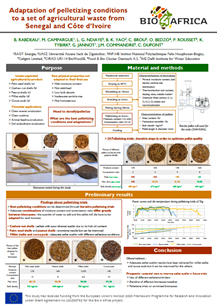Trials find the best biomass for feed pellets
Four out of five agricultural waste products show potential as a new source of rural revenue
BIO4Africa partner RAGT Energie has tested five types of agricultural waste from Côte d’Ivoire and Senegal to find out which ones work best in raw biomass pellets for feed. After a total of 30 trials, millet seeds and cocoa pods emerged as the clear top performers.
Each biomass sample was evaluated for properties such as moisture content, bulk density and particle size distribution. Batches were then ground, mixed and fed into the pelleting press. The objective was to identify the optimal combination of moisture content and compression ratio to produce the best quality pellets.
“Producing pellets with these kinds of feedstock can be challenging because their physical properties create technical challenges. Through our trials, we were able to determine how each biomass could be adapted to pelletising conditions,” says Benjamin Rabdeau, biomass and energy design engineer at RAGT Energie.
Advantages for farmers
Raw biomass feed pellets are cheap to transport and easy for farmers to handle and store. In other words, they offer a series of key advantages over untreated biomass, which typically deteriorates much more quickly.
“Although feed pellets are widely produced using standard feed raw materials, there is still a lot to learn about other sources of biomass, such as these agricultural waste products,” Benjamin comments.
“What our trials show is that pelletising is an appropriate technology for utilising agricultural residues. For crop-growing farmers, that’s an opportunity to turn waste into income. Livestock farmers, on the hand, gain high-quality feed pellets made from local raw materials.”
Not all of the five waste samples proved suitable for pelletisation. Cashew nut shells failed to pass the characterisation tests due to their high oil content. The remaining four, however, look promising. Apart from the top-performing millet stalks and cocoa pods, palm seed shells and peanut shells show good potential with further optimisation.
Click on the poster to see the study results presented by RAGT Energie at the European Biomass Conference & Exhibition 2023
